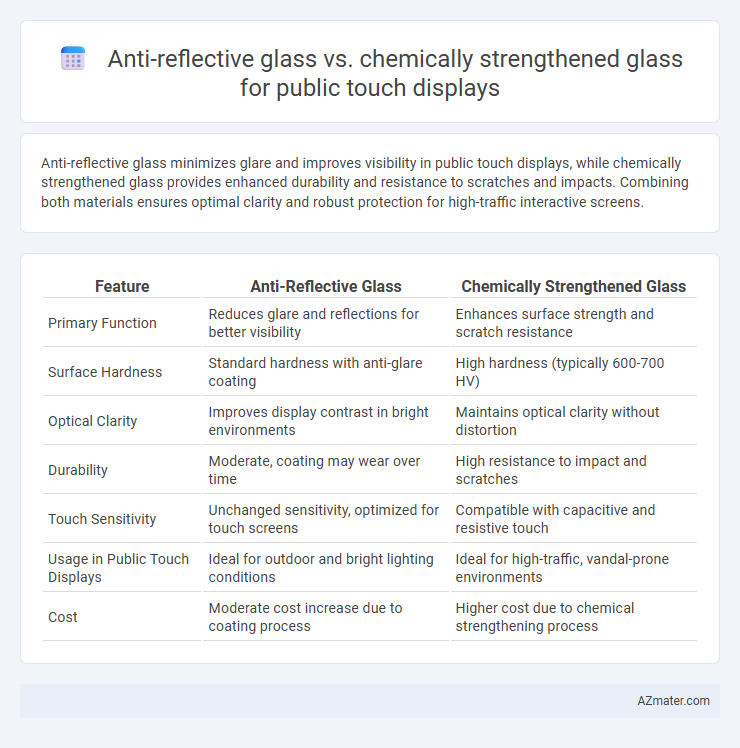Anti-reflective glass minimizes glare and improves visibility in public touch displays, while chemically strengthened glass provides enhanced durability and resistance to scratches and impacts. Combining both materials ensures optimal clarity and robust protection for high-traffic interactive screens.
Table of Comparison
| Feature | Anti-Reflective Glass | Chemically Strengthened Glass |
|---|---|---|
| Primary Function | Reduces glare and reflections for better visibility | Enhances surface strength and scratch resistance |
| Surface Hardness | Standard hardness with anti-glare coating | High hardness (typically 600-700 HV) |
| Optical Clarity | Improves display contrast in bright environments | Maintains optical clarity without distortion |
| Durability | Moderate, coating may wear over time | High resistance to impact and scratches |
| Touch Sensitivity | Unchanged sensitivity, optimized for touch screens | Compatible with capacitive and resistive touch |
| Usage in Public Touch Displays | Ideal for outdoor and bright lighting conditions | Ideal for high-traffic, vandal-prone environments |
| Cost | Moderate cost increase due to coating process | Higher cost due to chemical strengthening process |
Introduction: The Importance of Glass Selection for Public Touch Displays
Choosing the right glass for public touch displays significantly impacts durability, visibility, and user experience. Anti-reflective glass enhances screen clarity by reducing glare and reflections, making outdoor and brightly lit environments easier to view. Chemically strengthened glass offers superior impact resistance and scratch protection, ensuring longevity and safety in high-traffic public settings.
Overview of Anti-Reflective Glass
Anti-reflective glass for public touch displays reduces surface glare by minimizing light reflection through specialized coatings, enhancing screen visibility in bright environments. This type of glass improves user experience by providing clearer image quality and better touch sensitivity compared to untreated glass. While chemically strengthened glass increases durability and resistance to impact via ion exchange processes, anti-reflective glass primarily focuses on optical performance to ensure readability in high-ambient-light conditions.
Key Features of Chemically Strengthened Glass
Chemically strengthened glass for public touch displays offers enhanced durability through ion exchange processes that create a compressive surface layer, significantly increasing scratch resistance and impact strength compared to standard glass types. This type of glass maintains high optical clarity and touch sensitivity, ensuring accurate user interaction without compromising display brightness or color fidelity. Its resistance to chemical corrosion and thermal stress makes it ideal for high-traffic public environments where long-lasting performance and minimal maintenance are crucial.
Optical Clarity and Light Transmission Comparison
Anti-reflective glass for public touch displays enhances optical clarity by reducing surface glare and reflections, significantly improving visibility in bright environments. Chemically strengthened glass offers robust durability and scratch resistance but can slightly reduce light transmission due to its denser surface layer. For optimal light transmission and clear visuals, anti-reflective coatings outperform chemically strengthened glass in maintaining display brightness and sharpness under diverse lighting conditions.
Surface Durability and Scratch Resistance
Anti-reflective glass for public touch displays minimizes glare and improves visibility but tends to have moderate surface durability and scratch resistance, making it susceptible to everyday wear and tear. Chemically strengthened glass undergoes ion exchange processes that significantly enhance surface hardness, providing superior scratch resistance and durability against impacts and abrasions in high-traffic environments. Choosing chemically strengthened glass is ideal for public displays requiring long-lasting protection and maintenance of screen clarity over time.
Glare Reduction and User Visibility
Anti-reflective glass significantly reduces glare by minimizing surface reflections, enhancing user visibility on public touch displays even under direct sunlight or bright lighting conditions. Chemically strengthened glass offers superior durability and scratch resistance but does not inherently improve glare reduction, which can result in decreased visibility in high-glare environments. Combining chemically strengthened glass with an anti-reflective coating optimizes both durability and visibility, making it ideal for public touchscreens exposed to frequent use and variable lighting.
Fingerprint Resistance and Cleanability
Anti-reflective glass enhances public touch displays by reducing glare and improving visibility, but it may not inherently resist fingerprints or facilitate easy cleaning. Chemically strengthened glass offers superior durability and scratch resistance, significantly improving fingerprint resistance and enabling more effective cleaning processes. Combining anti-reflective coatings with chemically strengthened glass optimizes both visibility and maintenance, ensuring clear, smudge-free public touch interfaces.
Cost Analysis: Anti-Reflective vs Chemically Strengthened Glass
Anti-reflective glass typically incurs higher initial costs due to specialized coatings that reduce glare and improve visibility in public touch displays. Chemically strengthened glass, while offering superior durability and scratch resistance through ion exchange processes, often has a higher manufacturing cost but lower maintenance expenses over time. Evaluating total cost of ownership reveals anti-reflective glass may be more expensive upfront, whereas chemically strengthened glass provides cost savings through enhanced longevity and reduced replacement frequency.
Application Suitability in Public Environments
Anti-reflective glass significantly improves visibility and reduces glare in bright public environments, enhancing user experience on outdoor touch displays, while chemically strengthened glass offers superior durability and resistance to scratches and impacts, making it ideal for high-traffic areas prone to vandalism. Public touch displays benefit from chemically strengthened glass in subway stations and interactive kiosks where mechanical stress is high, whereas anti-reflective coatings are crucial in outdoor advertising and information panels exposed to direct sunlight. Combining both technologies can optimize performance, ensuring clear visibility and robust protection for various public applications.
Conclusion: Choosing the Best Glass for Public Touch Displays
Anti-reflective glass enhances visibility and reduces glare, making it ideal for outdoor public touch displays exposed to direct sunlight. Chemically strengthened glass offers superior durability and scratch resistance, ensuring long-lasting protection in high-traffic areas prone to heavy use and vandalism. Selecting the best glass depends on prioritizing either optimal screen clarity with anti-reflective coatings or maximum toughness with chemically strengthened layers for durable public touch interfaces.

Infographic: Anti-reflective glass vs Chemically strengthened glass for Public touch display
 azmater.com
azmater.com